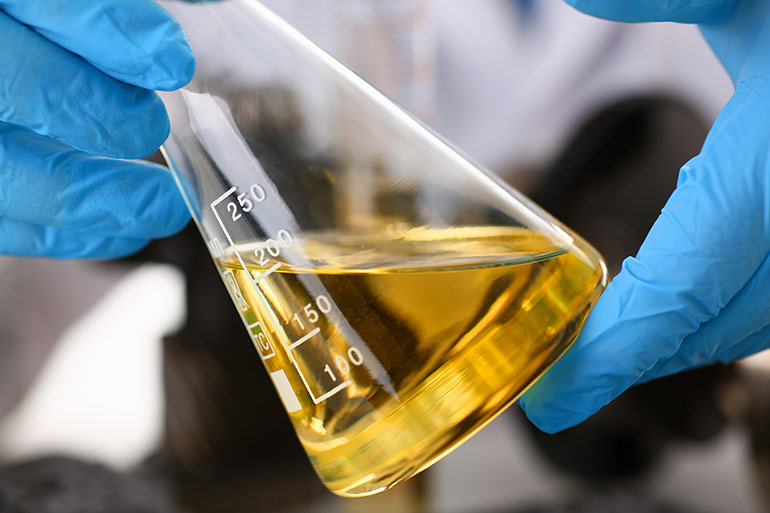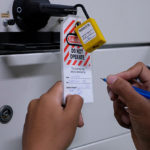By Josh Cosford, Contributing Editor
This article is the first in our series on hydraulic oil analysis programs. Hydraulic oil is the lifeblood of your hydraulic system, circulating primarily as a power transmission medium but also acting to lubricate, cool, seal and help remove contamination. Without oil, your hydraulic system is just a comatose pneumatic system, lying lifeless with no force potential. It seems like I’m pandering because the importance of hydraulic oil is so obvious that you’d be ignorant to think any work can be achieved without it. Regardless, hydraulic oil is taken for granted, especially when you consider how poorly it is treated, broadly speaking.
Given that hydraulic oil gives its soul to its purpose, you’d be amiss to neglect all its wants and needs in return. It wants to be cool and clean and provide the opportunity to excel in its role. However, you can only assume the oil’s well-being besides watching actuators move loads. Meanwhile, the oil may ail from the mechanical equivalent of diabetes, hypertension and high cholesterol.

To truly discover your oil’s health, you must test for the qualities that highlight its capacity to support the hydraulic components in which it circulates. Viscosity, lubricity, contamination, water, acidity, additives, and foaming characteristics constitute a comprehensive battery of tests to gauge hydraulic oil health. Each provides insight into fluid health and the machine as a whole.
To elucidate these oil insights, you must initiate regular testing through a sample and analysis program. Such a program involves the extraction of active hydraulic fluid, which is placed into a bottle and provided to your local laboratory for analysis of the abovementioned parameters. Most of your local fluid power distributors will offer such a program, so contact your “guy.” If you don’t already have a guy, find one — fluid power professionals on your side are an indispensable resource. Otherwise, you can always search “hydraulic oil analysis” online.
When you do find a label to work with, they’ll ask which parameters you wish to measure and offer a cost package appropriately scaled to your needs. Other labs will offer a complete hydraulic package, while others may provide a few service tiers for a different fee. Choose the most comprehensive test because it’s still a relatively inexpensive method to diagnose machine health.
The lab will provide you with a sample bottle for each test for each machine. There are a few methods to take your sample, just be aware that you want active oil that has been out doing it’s thing in the system. Collecting from the reservoir drain is a bad idea because the sample point is likely filled with dirt in a location away from the stream of fluid returning to the tank. You want to take an untainted sample while avoiding adding any contamination during the process.
The simplest method is to use a hand-operated suction pump that’s been flushed with clean oil a couple of times. A brake bleed hand pump works well, too. The ideal method is to install a sample point, such as in the return line. Add a branch tee just before your filter, install a test point, and then, when sampling, install a microbore test point hose. Just connect the hose, fill your bottle, and then remove the hose before replacing the test point’s protective cap. Don’t worry that you’re sampling pre-filtered oil. If your oil is so dirty before passing through your filter that it skews this test, you have more significant problems than where you’re sampling oil.
Once the sample is obtained, be sure all paperwork and labels are correctly filled, including the date, machine number, type and volume of oil and any other important information you want to identify this sample. Upon repeat samples, you want to be sure the lab tracks data for the same machine.
Your sample is now ready for transport to the lab and is okay to be shipped via a courier or your preferred method (no need to fill out any dangerous goods paperwork). The lab will do its thing, send you a report, and offer specific advice on remedying any red flags they measure. This is where your local fluid power guy comes in handy. Whatever ailment affects your machine can be improved with their help, especially from well-trained and certified fluid power professionals.
Finally, you must consider how frequently you wish to sample your oil, and it depends on who you ask. Like changing your vehicle’s oil, you can schedule based on the calendar or machine hours. Annual testing is the minimum for any solid data, but every 1,000-3,000 hours of machine time if you run a high-volume production plant and three shifts. Also, consider your own cost of downtime — if you’re a tier 1 automotive supplier with just-in-time methodology, you’ll want to be on the safe end of the testing frequency, and perhaps every 2-3 months, especially for expensive machines.
Over the following seven articles, I will discuss the various test parameters commonly used to help diagnose hydraulic oil health. I’m always of the opinion that hydraulic oil should last indefinitely, and with a complete understanding of your oil’s critical parameters, you’ll never be caught off guard by having to replace expensive hydraulic fluid.







Leave a Reply